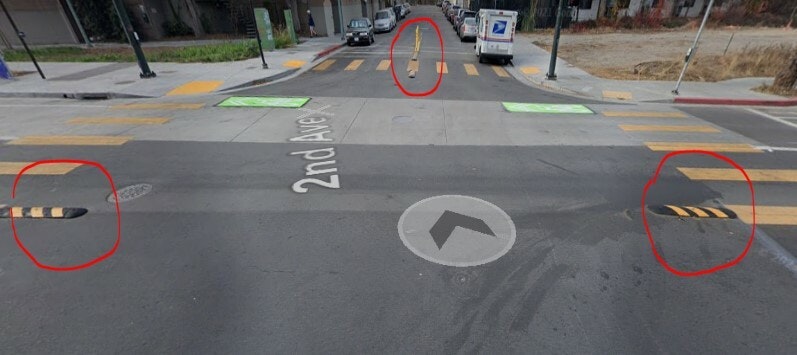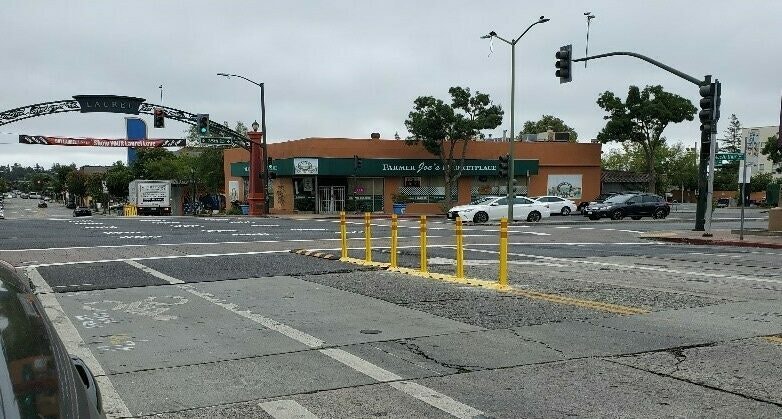Sideshow Prevention Efforts

Sideshows and related dangerous driving behaviors including "donuts" are a significant safety and quality of life concern for Oakland residents - as well as the region, are impacting our streets, and are a vexing challenge for local governments.
See Director Rowan Spotlight Recent Pilot Efforts
Background
There is no established best practice or evidence of effective engineering treatments to prevent this type of dangerous driving behavior, and any of the hundreds of intersections in Oakland are theoretically a potential location for sideshows, "donuts" or stunt driving. The City of Oakland has been working with agencies throughout the region to develop, test and implement strategies to mitigate this growing concern.
Because there are no established best-practice strategies to prevent sideshows, the City has embarked on an inter-departmental pilot led by the Oakland Police Department (OPD) and the City Administrator's Office with support from the Oakland Department of Transportation (OakDOT) to pilot engineering strategies to support enforcement efforts at some of the most impacted intersections in Oakland. Proactive enforcement tools and creative legislation lead the way to address sideshows, with engineering complementing a multi-faceted approach.
OakDOT has led the nation with this innovative work to deter sideshows, which initiated beginning in 2021 and continues to evolve with support from City leadership to help address this issue that adversely impacts on the safety and quality of life of Oakland communities.
Engineering treatments will continue to balance the need for deterring sideshows with preserving the functionality of our streets for all road users.
Treatments
Phase 1 of the sideshow prevention pilot has focused primarily on reducing the amount of open space for sideshows to take place by including vertical elements in the intersection that have safety co-benefits. Any change in road design that reduces the size of available space may be used, including curb extensions and traffic islands, and can be installed using temporary material or traditional long-term material such as concrete. The selection of the type of treatment is dictated by the built environment and geometry of the intersection. The main tool for accomplishing this to date has been "Hardened Centerline" (explained below in the FAQ) because OakDOT has found this treatment is often the most cost-effective strategy.
Phase 2 of the pilot, initiated in 2024, is exploring new treatments to alter the street surface to deter sideshows. OakDOT is exploring the use of alternative materials to Bott's Dots, such as steel plates, that can modify the pavement in addition to reducing the size of the intersection and that are less maintenance intensive. An example of this type of installation can be found at Foothill Boulevard/Seminary Avenue.
Pilot Projects
Updated: July 2024
The locations of engineering treatments to try to deter sideshows/donuts/dangerous driving in Oakland are summarized below, along with their current status. Locations numbered 1-14 were identified by OPD as heavily impacted locations; locations 15-22 were identified by elected officials:
- 35th Avenue/MacArthur: Installation was completed on July 9th, 2021.
- Fairfax/Foothill: Installation was completed on August 18th, 2021.
- High/MacArthur: Installation was completed on October 15th, 2021.
- *42nd Avenue/International Blvd: Installation was completed on October 19, 2022.
- *42nd Avenue under I-880 (known as "the Pit"): Caltrans' installation was completed on June 16th, 2022.
- 106th Ave/MacArthur: Installation was completed on September 28, 2022.
- 55th Ave/Foothill: Installation was completed on August 31st, 2022.
- 82nd Ave/MacArthur: Installation was completed on August 23rd, 2022.
- Seminary Ave/MacArthur: Installation was completed on August 29, 2022.
- *98th Ave/International Blvd: Intersection is in Caltrans right-of-way and treatments are subject to state approval.
- 66th Ave/International Blvd: Installation was completed on April 30th, 2024.
- 15th Ave/International: Installation is planned for Summer 2025.
- 66th Ave/Coliseum Way: Installation is planned for Summer 2025.
- 16th Ave & International Blvd: Installation is planned for Summer 2025.
- MacArthur Blvd/Coolidge Ave: Installed 2022.
- MacArthur Blvd/Fruitvale Ave: Evaluating Alternative Treatments
- Foothill Blvd/Seminary Ave: Installed June 2024
- Redwood Rd/Skyline Blvd: Installed June 2024
- Park Blvd/Excelsior Ave/Grosvenor Pl/Alma Pl: Evaluating Alternative Treatments
- MacArthur Blvd/Ritchie St: Installation is planned for Summer 2025
- 45th St/Market St: Installation is planned for Summer 2025
- East 21st St/21st Ave: Timeline to be determined
*Intersection is in Caltrans right-of-way and the installation of treatments requires state approval
Frequently Asked Questions (FAQ)
How can my intersection be included in the sideshow prevention pilot?
The City of Oakland recognizes the widespread and pervasive nature of sideshow behavior across the City; however, the City must prioritize the limited resources for sideshow prevention and deterrence for the most impacted locations and relative to other critical safety needs facing Oaklanders. OakDOT will continue to collaborate with OPD and City leaders to identify candidate locations for Phase 2 of the pilot based on changing needs and the effectiveness of treatments at previously piloted locations.
The City has set up a new category in the City's 311 Call Center and website to specifically track public requests for sideshow prevention measures, and residents are encouraged to utilize 311 for sideshow prevention requests. 311 requests are one of many datapoints to inform the selection of future locations for the pilot.
Is the sideshow prevention pilot effective?
The sideshow prevention pilot's immediate objective is to deter and discourage sideshows at the pilot locations. OakDOT coordinates with OPD to assess whether sideshows are continuing at the pilot locations or whether they are relocating to other locations. In addition to assessing the effectiveness of deterring sideshow behaviors, OakDOT is also monitoring maintenance needs required for these installed treatments and receiving qualitative feedback from stakeholders including our Bicyclist and Pedestrian Advisory Commission.
What is a hardened centerline?

Hardened centerline treatment extending into the intersection
They reduce vehicle speeds while turning, when crashes - including those involving pedestrians - are more likely to occur. This type of treatment must be installed in areas outside of travel paths

Hardened centerline with safe-hit posts
Preliminary data suggests the effectiveness of hardened centerlines on discouraging sideshows depends on the characteristics of the intersection being treated, and how much we are able to "reduce" the space available for sideshows to occur. This includes the geometry of the intersection and the operation of larger vehicles turning through the intersection such as buses. These characteristics will dictate the length of hardened centerline we can install without impacting the regular flow of traffic, including how far the hardened centerline may extend into the intersection. This will in turn impact how much we are able to "reduce" the space available for sideshows
What are sideshow prevention installations using steel plates and how do they work?
Steel plates are commonly used on roadway construction projects when excavation is required to repair underground utilities beneath the roadway surface. The steel plates are there to cover the excavated area and allow traffic to continue using the roadway in between construction hours. A small asphalt ramp is typically installed around the perimeter of the steel plates to ramp traffic between the plate and roadway surface.
In June 2024, OakDOT began experimenting with installing steel plates temporarily to interfere with sideshow activity. The goal is to place them in a pattern to disrupt the rotational movement of the back end of an automobile while allowing regular traffic to continue using the roadway. Steel plate warning signs were installed on every approach to the intersection.

Steel Plate Installation at Foothill and Seminary
Why doesn't OakDOT use Bott's Dots?
While Phase 1 attempted this approach using 4-inch ceramic dots, or "Bott's Dots", Bott's Dots have unfortunately been proven ineffective over time. Community stakeholder feedback requested the use of Bott's Dots to be put on hold due to the impact on regular traffic, including people bicycling and motorcycling. The City of Oakland Bicyclist and Pedestrian Advisory Commission (BPAC) has expressed concerns with Bott's Dots creating difficult and slippery conditions (especially after rain) for bicyclists and motorcyclists to traverse an intersection, while noting that hardened centerlines did not pose the same challenges. Additionally, Bott's Dots installations have required more maintenance when compared to hardened centerline installations. OakDOT is exploring alternative treatments to Bott's Dots in Phase 2 of the pilot to achieve similar alterations to the street surface while avoiding the safety and maintenance challenges of Bott's Dots.